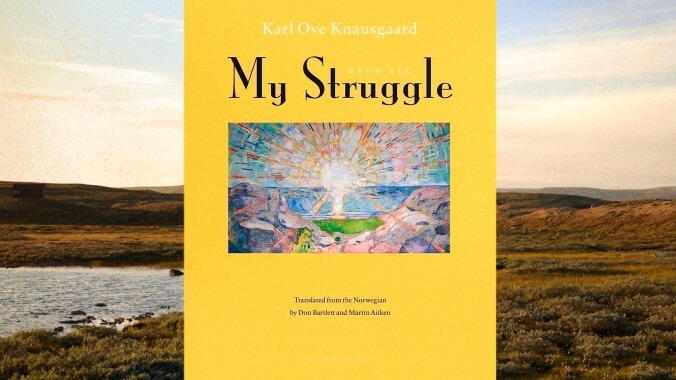Karl Ove Knausgaard is the most well-documented writer alive today. Across the first five volumes of My Struggle, the Norwegian novelist rendered in exacting detail seemingly every memory he could access. These recollections are often painful (Book One dealt largely with Karl Ove and his brother, Yngve, cleaning up the physical mess left behind by their alcoholic father’s death), frequently embarrassing (see a late-blooming Karl Ove learning how to masturbate with a mail-order volume of Renaissance art in Book Five) and, more than anything, banal: If you’ve ever wondered how frequently a style-conscious Norwegian teenager might have gone grocery shopping in the mid-1980s, Book Four has you covered.
If that sounds boring, that’s at least part of the point. Since the publication of the first two volumes of My Struggle in 2009, Knausgaard has been lauded for his level of disclosure, but the radicalism of his confessions rests as much in their volume as it does their content. Early in Book Six, he notes that what forms a life are the moments he takes for granted—a smoke on the balcony, pausing to choose between mass-produced ice-cream brands, driving to a neighboring town to buy a stereo—and he treats these moments with the same care with which a more conventional author might treat their characters’ most poignant epiphanies. The idea that life is a series of events containing no real meaning in themselves is hardly revolutionary, but most authors have followed this path to either nihilism or a kind of college-sophomore brand of Romanticism. Knausgaard, ever Scandinavian, simply allows his memories to breathe and invites us to watch as his narrative comes more alive the more oxygen it takes in.
True to form, Book Six, subtitled The End, stretches much of its opening third across a single afternoon. Karl Ove and his friend Geir laze in a park. They watch their kids run around. They bat a few ideas back and forth and amicably disagree the way old friends do. But the scene is darkened by an email from Karl Ove’s Uncle Gunnar, who has read a ready-to-print version of the first volume of My Struggle and, in an email titled “Verbal rape,” claims to have proof that Knausgaard père’s final days weren’t nearly as gruesome as the book suggests. The question of validity has always hung over My Struggle—it’s billed as a “novel,” after all, and Knausgaard is at pains to remind us of the faultiness of his memory—but the possibility that he’s fundamentally misremembered the scene of his father’s death, and thus the defining moment of both his life and his work, nearly topples him.
As the implications of Gunnar’s accusation grow, they push Karl Ove out of the present, sending the narrative into a spiral of justification in the form a 400-page self-contained essay that sits at the center of the book and virtually kills its momentum. Knausgaard winds an extraordinarily dense explication of a Paul Celan poem and an examination of the relationship between the literary “I,” “we,” “you,” “they,” and “it” around a nuanced reading of Hitler’s early life and motivations. It’s meant to be an explanation as to why Knausgaard named his masterwork after the dictator’s autobiography, but the writing here is often muddy and technical in the way that only the work of a one-time graduate student can be: “That which ‘is’ becomes ‘was’ through the ‘I,’ who turns it into ‘is’ by the evocation of memory,” goes one particularly knotty sentence. Given the relative lucidity of the essay’s biographical sections, this is maybe the only book in print in which reading about Hitler comes as a relief.
Buried beneath the jargon are legitimate literary reasons for this turn, but it’s a lot to ask a reader who’s flipped through the previous 3,000 pages to suddenly start power-lifting. Knausgaard’s obfuscations give him space to question how the same conditions can make one person a monster but not another, and to finally accept (and subsequently relinquish) the depth of his father’s influence. But there’s a difference between describing the machinations of a phenomenon and simply evoking it, just as there’s a difference between someone’s participation in an event and their experience of it.
Which is ultimately Knausgaard’s point. It’s driven home in the book’s final third, which chronicles his (now-ex) wife Linda’s nervous breakdown, triggered by the publication of Book Two; her only way through it is via patient suffering and professional help, and all he can really do is bear witness as her life demands she be treated as something more than a character in someone else’s narrative. “Linda is a human being and her unique essence is indescribable,” he writes on the book’s last page. “It didn’t reside in what she did, it didn’t reside in what she said, it resided in what she was.”
In the end, it seems, there is no such thing as full disclosure—not just because it’s impossible to remember everything that’s ever happened, but also because life simply can’t be defined. To believe otherwise is to wrestle with mist. Still, this final book makes plain what the author has been doing all along. With these six volumes, Karl Ove Knausgaard set out to grapple his life into submission. Here’s a spoiler: He loses the struggle.


 Keep scrolling for more great stories from The A.V. Club.
Keep scrolling for more great stories from The A.V. Club.